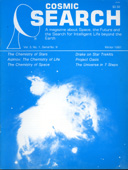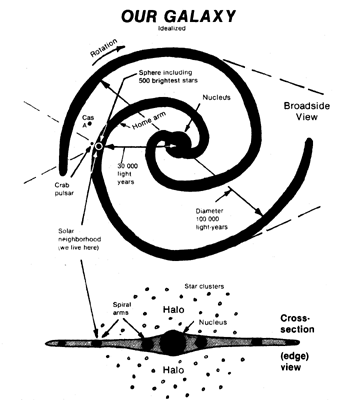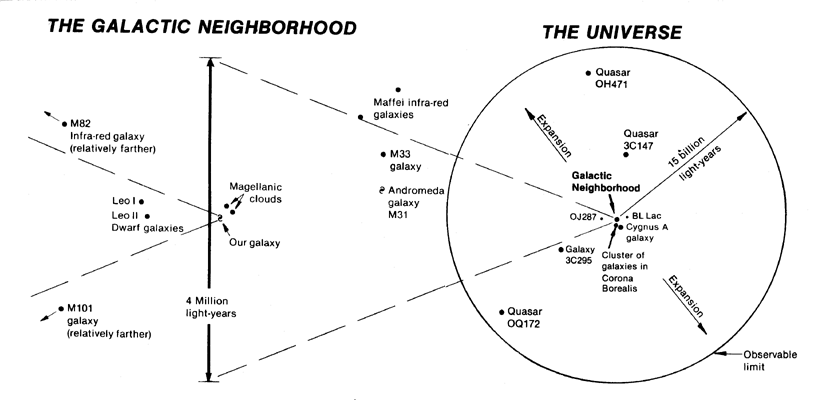![[NAAPO Logo]](../../Images/NAAPOsm.jpg) North American AstroPhysical Observatory (NAAPO)
|
|
ABCs of Space
By: John Kraus
THE UNIVERSE IN SEVEN STEPS
The topic for this issue is a continuation of "The Universe in Seven Steps" taken from my new book OUR COSMIC UNIVERSE (Cygnus-Quasar Books).* (*Copyrightę John D. Kraus 1980)
Step 1: "The Earth and Its Rings" was described in ABCs of Space in the Summer 1980 issue (Serial no. 7). Step 2: "The Earth-Moon System," Step 3: "The Solar System," and Step 4: "The Solar Neighborhood" were described in the last issue (Year End 1980, Serial no. 8).
In this issue we complete our journey across the universe via Step 5: "Our Galaxy," Step 6: "The Galactic Neighborhood" and Step 7: "The Universe."
For most of us, it is natural to think of our dwelling in relation to the yard outside, the local neighborhood, the town, the neighboring towns, the state or province, the country, the continent and the world.
In the same way, with a more cosmic perspective, all dwellers of Planet Earth should think of our home (the Earth) in relation to the Solar System, the Solar Neighborhood, our Galaxy, the Galactic Neighborhood and the Universe.
I hope that "The Universe in Seven Steps" helps to convey this perspective of our true place in the universe.
Step 5. Our Galaxy. The sun and 100 billion other stars form a huge aggregation called our galaxy (or Milky Way system), a flattened disc 100,000 light years in diameter turning like a great wheel once in 300 million years. The sketches show it as seen broadside and edge-on. In the nucleus at its center and in the long trailing spiral arms the stars are closer together than between the arms.
Surrounding the disc, like a swarm of bees, are a few hundred star clusters and a sprinkling of individual stars. These clusters and stars form a galactic halo, a spherical region centered on the nucleus. Some of the clusters may contain as many as 100,000 stars or more.
The solar system where we live is in a spiral arm about two-thirds of the way to the edge (30,000 light-years from the center). Most of the 500 brightest stars in the sky are relatively close (within 1000 light-years). The Crab pulsar and Cassiopeia A (Cas A) are further from the solar neighborhood.
The solar neighborhood sketch must be reduced by a factor of 5000 from the Step 4 diagram to be the correct size on the galaxy diagram. The dot showing the solar neighborhood should be about 100 times smaller in diameter to indicate its proper relative size. The sketch is idealized.
Step 6. The Galactic Neighborhood. Our galaxy and some nearby galaxies such as the Magellanic clouds and the Andromeda galaxy form the galactic neighborhood.
Our galaxy sketch must be reduced by a factor of 40 from the Step 5 diagram to be the correct size on the galactic neighborhood diagram. Our galaxy and the other galaxies are approximately the proper relative size.
Step 7. The Universe. The known universe contains our galaxy and 100 billion other galaxies out to a celestial horizon or observable limit at a radius of 15 billion light years. The other galaxies seem to be moving away as though the universe were expanding, the recession velocity increasing with the distance.
The galactic neighborhood is shown at the center with a few radio galaxies such as Cygnus A and 3C295 at increasing distances. The most distant known object, quasar OQ172, is receding at 91 percent of the velocity of light.
The galactic neighborhood diagram must be reduced by a factor of 7500 from the Step 6 diagram to be the proper relative size. The dots showing the galactic neighborhood and other objects are relatively much too large.
The light and radio waves we receive from the quasar O0172 have been traveling nearly 14 billion years to reach us. This means that we observe it, not as it is today, but as it was nearly 14 billion years ago. The farther an object is from us, the farther back in time we see it.
|


